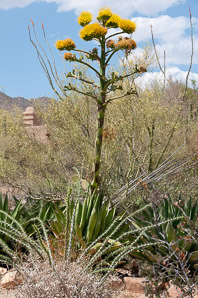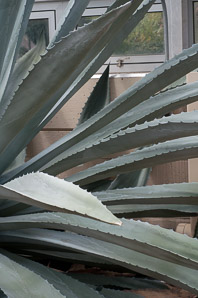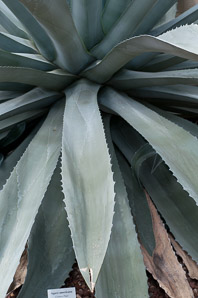
|
Agave americana L. Century plant, American century plant
These striking plants have a rounded array of sharply pointed, blue-gray leaves at the bottom, and an amazing flowering stalk that can reach as much as 26′ (8 m) in height, way above the leaves. The leaves can reach 6′ (1.8 m) in length; the rosette can be 13′ (4.0 m) in diameter. They are extremely tolerant of drought. Identification: These plants are named in the partially mistaken belief that they take a century to bloom, and die after the first bloom. It really does take about ten years to bloom under ideal circumstances, and up to 60 in cooler climates. And it really does die after it blooms, although shoots from the main plant continue to grow. Hence waiting for the unmistakable large stalk of yellow flowers may require more patience than you have. It is unusually large size, 6-10′ (1.8-3 m) . Leaves are 3-6½′ (1-2 m) long and 6-10″ (15-25 cm) wide. They are smooth and very rigid, gray-green or bluish, with dark brown teeth along the edges. Yellow blooms appear on stalks 16-26′ (5-8 m) high, branched at the top into 15-35 branches. Edibility: Sap from broken leaves causes painful irritation or severe dermatitis. Indians of pre-Columbian Mexico cut the flower stems before they flowered, and collected a liquid that they fermented. Online References:
The Texas AgriLife Extension Service and Texas A&M University, Texas A&M System Cactus Art: the World of Cacti & Succulents The University of Connecticut Ecology and Evolutionary Biology Plant Growth Facilities Plants for a Future, a resource and information centre for edible and otherwise useful plants The Lady Bird Johnson Wildflower Center SEINet—the Southwest Environmental Information Network References:
Irish, Mary & Irish, Gary, Agaves, Yuccas and Related Plants: A Gardener’s Guide, Timber Press, 2000, p. 94-97 Ingram, Stephen, Cacti, Agaves and Yuccas of California and Nevada, Cachuma Press, 2008, p. 185 5/24/2009 · Arizona Sonora Desert Museum, Tucson, Arizona 5/24/2009 · Arizona Sonora Desert Museum, Tucson, Arizona
Agave americana description by Thomas H. Kent, last updated 6 Sep 2021. © FloraFinder.org. All rights reserved. |
5/24/2009 · Arizona Sonora Desert Museum, Tucson, Arizona 4/6/2011 · Howard Peters Rawlings Conservatory & Botanic Gardens, Druid Hill Park, Baltimore, Maryland 4/6/2011 · Howard Peters Rawlings Conservatory & Botanic Gardens, Druid Hill Park, Baltimore, Maryland 9/7/2010 · Tower Hill Botanic Garden, Boylston, Massachusetts Range: Zones 8a-11:
|








